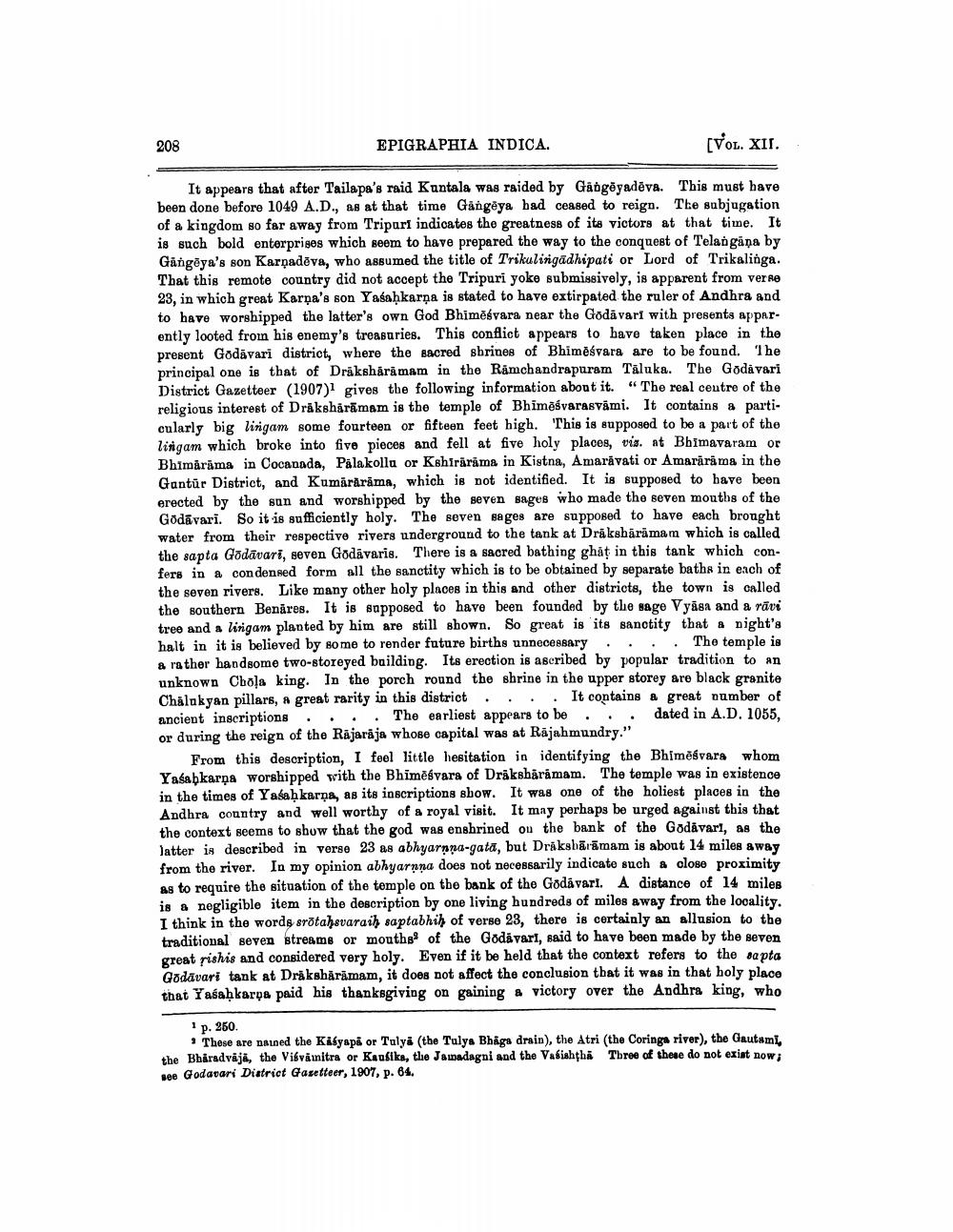________________
208
EPIGRAPHIA INDICA.
[VOL. XII.
It appears that after Tailapa's raid Kuntala was raided by Gaðgöyadėva. This must have been done before 1049 A.D., as at that time Gångeya had ceased to reign. The subjugation of a kingdom so far away from Tripari indicates the greatness of its victors at that time. It is such bold enterprises which seem to have prepared the way to the conquest of Telangana by Güngöya's son Karpadova, who assumed the title of Trikulirigadhipati or Lord of Trikalinga. That this remote country did not accept the Tripuri yoke submissively, is apparent from verre 23, in which great Karna's son Yaśaḥkarņa is stated to have extirpated the ruler of Andhra and to have worshipped the latter's own God Bhimēśvara near the Godavari with presents appar. ently looted from his enemy's treasuries. This conflict appears to have taken place in the present Godavari district, where the sacred shrines of Bhimēśvara are to be found. The principal one is that of Dräkshärămam in the Ramchandrapuram Taluka. The Godavari District Gazetteer (1907)1 gives the following information about it. The real centre of the religious interest of Drakshärāmam is the temple of Bhimēśvarasvami. It contains a particularly big lirigam some fourteen or fifteen feet high. 'This is supposed to be a part of the lisigam which broke into five pieces and fell at five holy places, vis. at Bhimavaram or Bhimirima in Cocanada, Palakollu or Kshirärama in Kistna, Amaravati or Amarará ma in the Gantur District, and Kumārārāma, which is not identified. It is supposed to have been erected by the sun and worshipped by the seven sages who made the seven mouths of the Godāvari. So it is sufficiently holy. The seven sages are supposed to have each brought water from their respective rivers underground to the tank at Drākshāramam which is called the sapta Godavari, seven Godavaris. There is a sacred bathing ghāt in this tank which confers in a condensed form all the sanctity which is to be obtained by separate baths in each of the seven rivers. Like many other holy places in this and other districts, the town is called the southern Benares. It is supposed to have been founded by the sage Vyāsa and a rāvi tree and a lirigam planted by him are still shown. So great is its sanctity that a night's halt in it is believed by some to render future births unnecessary . . . The temple is a rather handsome two-storeyed building. Its erection is ascribed by popular tradition to an unknown Cbola king. In the porch round the shrine in the upper storey are black granite Chalukyan pillars, a great rarity in this district . .. It contains a great number of ancient inscriptions . . . . The earliest appears to be . . . dated in A.D. 1055, or during the reign of the Rājarāja whole capital was at Rajahmundry."
From this description, I feel little hesitation in identifying the Bhimēsvars whom Yaśabkarna worshipped with the Bhimēsvara of Drākshårámam. The temple was in existence in the times of Yaśaḥkarna, as its inscriptions show. It was one of the holiest places in the Andhra country and well worthy of a royal visit. It may perhaps be urged against this that the context seems to show that the god was enshrined ou the bank of the Godavari, as the latter is described in verse 23 as abhyarnna-gata, but Dråksbārāmam is about 14 miles away from the river. In my opinion abhyarnna does not necessarily indicate such a close proximity as to require the situation of the temple on the bank of the Godávari. A distance of 14 miles is & negligible item in the description by one living hundreds of miles away from the locality. I think in the words srõtahsvaraih saptabhih of verse 23, there is certainly an allusion to the traditional seven streams or mouths of the Godavari, said to have been made by the seven great pishis and considered very holy. Even if it be held that the context refers to the sapta Godavari tank at Dräkshärāmam, it does not affect the conclusion that it was in that holy place that Yasahkarps paid his thanksgiving on gaining & victory over the Andhra king, who
p. 250.
These are named the Kibyapa or Tulya (the Tulya Bhaga drain), the Atri (the Coringa river), the Gautami, the Bharadvaja, the Visvamitra or Kausika, the Jamnadagni and the Vafishthá Three of these do not exist now see Godavari District Gasetteer, 1907, p. 64.




